英语专四语法总结:倒装结构
- 格式:docx
- 大小:37.71 KB
- 文档页数:2
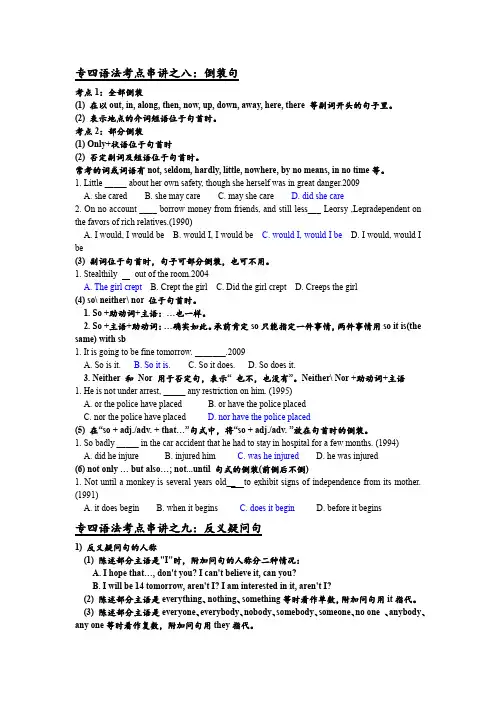
专四语法考点串讲之八:倒装句考点1:全部倒装(1) 在以out, in, along, then, now, up, down, away, here, there 等副词开头的句子里。
(2) 表示地点的介词短语位于句首时。
考点2:部分倒装(1) Only+状语位于句首时(2) 否定副词及短语位于句首时。
常考的词或词语有not, seldom, hardly, little, nowhere, by no means, in no time等。
1. Little _____ about her own safety, though she herself was in great danger.2009A. she caredB. she may careC. may she careD. did she care2. On no account ____ borrow money from friends, and still less___ Leorsy ,Lepradependent on the favors of rich relatives.(1990)A. I would, I would beB. would I, I would beC. would I, would I beD. I would, would I be(3) 副词位于句首时,句子可部分倒装,也可不用。
1. Stealthily out of the room.2004A. The girl creptB. Crept the girlC. Did the girl creptD. Creeps the girl(4) so\ neither\ nor 位于句首时。
1. So +助动词+主语:…也一样。
2. So +主语+助动词:…确实如此。
承前肯定so只能指定一件事情,两件事情用so it is(the same) with sb1. It is going to be fine tomorrow. _______.2009A. So is it.B. So it is.C. So it does.D. So does it.3. Neither 和Nor 用于否定句,表示“ 也不,也没有”。
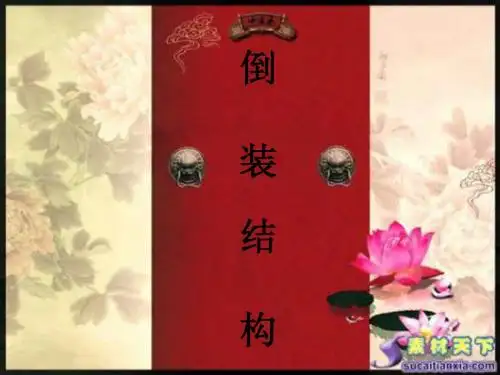
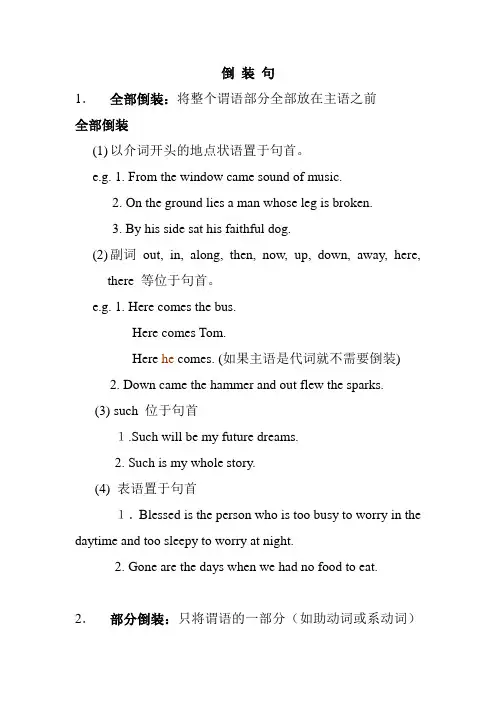
倒装句1.全部倒装:将整个谓语部分全部放在主语之前全部倒装(1)以介词开头的地点状语置于句首。
e.g. 1. From the window came sound of music.2. On the ground lies a man whose leg is broken.3. By his side sat his faithful dog.(2)副词out, in, along, then, now, up, down, away, here,there 等位于句首。
e.g. 1. Here comes the bus.Here comes Tom.Here he comes. (如果主语是代词就不需要倒装)2. Down came the hammer and out flew the sparks.(3) such 位于句首1.Such will be my future dreams.2. Such is my whole story.(4) 表语置于句首1.Blessed is the person who is too busy to worry in the daytime and too sleepy to worry at night.2. Gone are the days when we had no food to eat.2.部分倒装:只将谓语的一部分(如助动词或系动词)放在主语前面,其余部分仍在主语之后。
部分倒装(2)句首有否定词或否定短语时,句子要部分倒装。
A.常见的否定词有:never, hardly, scarcely, little, seldom, not, not until, rarely, no sooner…than, nowhere,etc.e.g. 1. Nowhere in the world can you find a man who ismore foolish than John.2. No sooner had I taken a bath than the bell rang.3. Not a word did he say at the meeting.4. Never before have I heard such a story.5. Not until he came back did I leave.(注意:主句中主谓结构部分倒装)6. Not only did we lose all our money, but we alsocame close to losing our lives.B.常见的否定短语有:in no way, in no case, at no time, by no means, in no sense, on no account, under nocircumstances放句首表示强调,译为“决不。

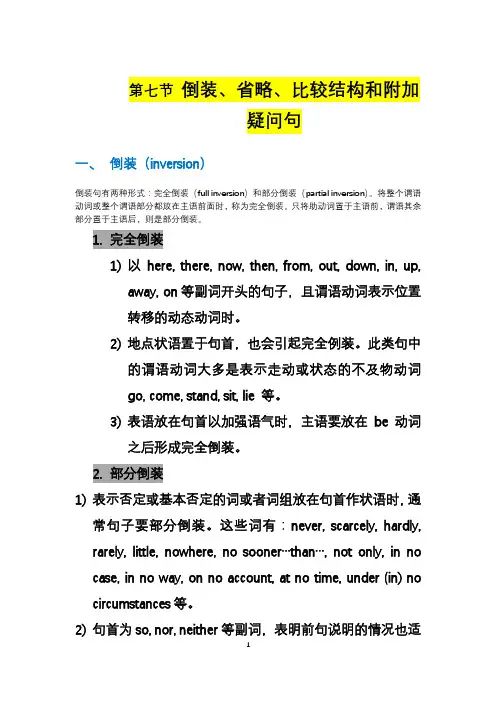
第七节倒装、省略、比较结构和附加疑问句一、倒装(inversion)倒装句有两种形式:完全倒装(full inversion)和部分倒装(partial inversion)。
将整个谓语动词或整个谓语部分都放在主语前面时,称为完全倒装。
只将助动词置于主语前,谓语其余部分置于主语后,则是部分倒装。
1.完全倒装1)以here, there, now, then, from, out, down, in, up,away, on等副词开头的句子,且谓语动词表示位置转移的动态动词时。
2)地点状语置于句首,也会引起完全例装。
此类句中的谓语动词大多是表示走动或状态的不及物动词go, come, stand, sit, lie 等。
3)表语放在句首以加强语气时,主语要放在be动词之后形成完全倒装。
2.部分倒装1)表示否定或基本否定的词或者词组放在句首作状语时,通常句子要部分倒装。
这些词有:never, scarcely, hardly, rarely, little, now here, no sooner…than…, not only, in no case, in no way, on no account, at no time, under (in) no circumstances等。
2)句首为so, nor, neither等副词,表明前句说明的情况也适用于本句时,通常句子要部分倒装。
(注意:当so放在句首只是对对方所陈述的内容表示肯定时,不用倒装。
)3)Only引出的状语放在句首时,一般都是部分倒装。
(注意:only属于主语的一部分时,不可用倒装结构)。
4)As引导的让步状语从句用倒装结构,将表语或谓语中的动词提前。
系动词be前置用倒装结构,引导让步状语从句。
二、省略(Ellipse)1)在以if, when, though, although, as, as if等连词引导的从句中,如果从句的主语和主句的主语一致,且从句主要动词是be时,通常省略从句的主语和系动词。
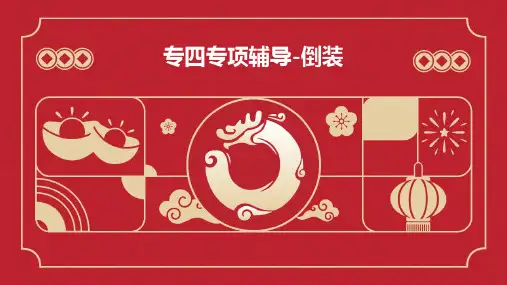
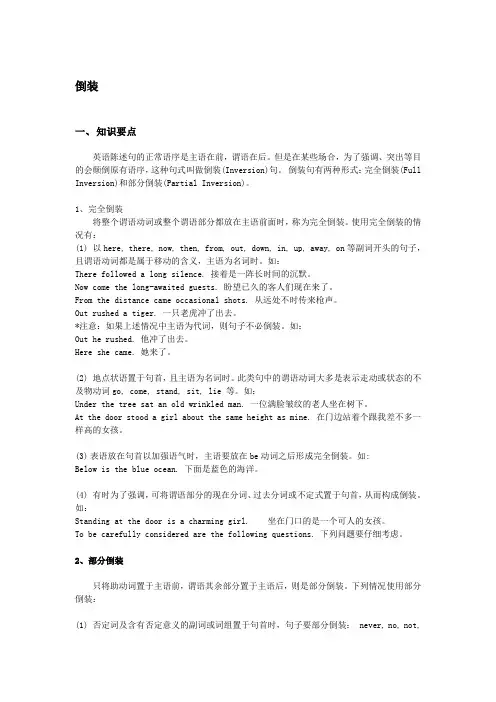
倒装一、知识要点英语陈述句的正常语序是主语在前,谓语在后。
但是在某些场合,为了强调、突出等目的会颠倒原有语序,这种句式叫做倒装(Inversion)句。
倒装句有两种形式:完全倒装(Full Inversion)和部分倒装(Partial Inversion)。
1、完全倒装将整个谓语动词或整个谓语部分都放在主语前面时,称为完全倒装。
使用完全倒装的情况有:(1)以here, there, now, then, from, out, down, in, up, away, on等副词开头的句子,且谓语动词都是属于移动的含义,主语为名词时。
如:There followed a long silence. 接着是一阵长时间的沉默。
Now come the long-awaited guests. 盼望已久的客人们现在来了。
From the distance came occasional shots. 从远处不时传来枪声。
Out rushed a tiger. 一只老虎冲了出去。
*注意:如果上述情况中主语为代词,则句子不必倒装。
如:Out he rushed. 他冲了出去。
Here she came. 她来了。
(2)地点状语置于句首,且主语为名词时。
此类句中的谓语动词大多是表示走动或状态的不及物动词go, come, stand, sit, lie 等。
如:Under the tree sat an old wrinkled man. 一位满脸皱纹的老人坐在树下。
At the door stood a girl about the same height as mine. 在门边站着个跟我差不多一样高的女孩。
(3)表语放在句首以加强语气时,主语要放在be动词之后形成完全倒装。
如:Below is the blue ocean. 下面是蓝色的海洋。
(4) 有时为了强调,可将谓语部分的现在分词、过去分词或不定式置于句首,从而构成倒装。
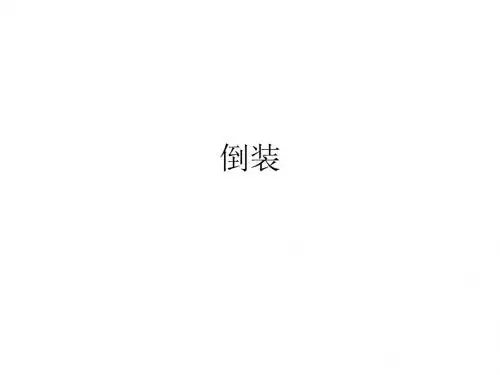
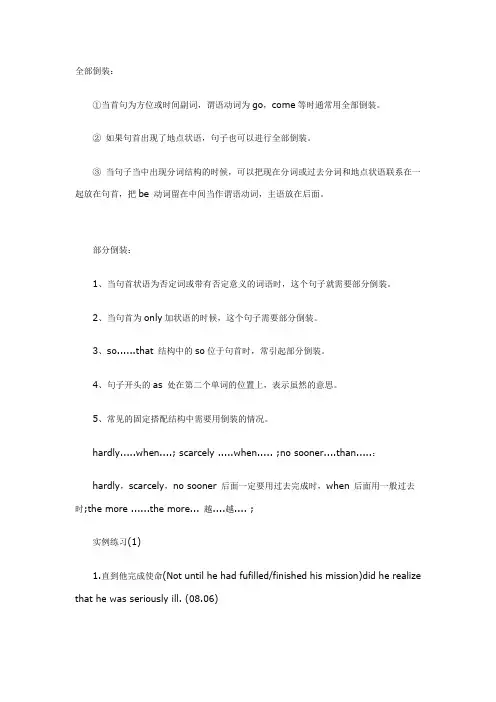
全部倒装:①当首句为方位或时间副词,谓语动词为go,come等时通常用全部倒装。
②如果句首出现了地点状语,句子也可以进行全部倒装。
③当句子当中出现分词结构的时候,可以把现在分词或过去分词和地点状语联系在一起放在句首,把be 动词留在中间当作谓语动词,主语放在后面。
部分倒装:1、当句首状语为否定词或带有否定意义的词语时,这个句子就需要部分倒装。
2、当句首为only加状语的时候,这个句子需要部分倒装。
3、so......that 结构中的so位于句首时,常引起部分倒装。
4、句子开头的as 处在第二个单词的位置上,表示虽然的意思。
5、常见的固定搭配结构中需要用倒装的情况。
hardly.....when....; scarcely .....when..... ;no sooner....than.....:hardly,scarcely,no sooner 后面一定要用过去完成时,when 后面用一般过去时;the more ......the more... 越....越.... ;实例练习(1)1.直到他完成使命(Not until he had fufilled/finished his mission)did he realize that he was seriously ill. (08.06)2. The witness was told that under no circumstance ( should he lie to the court ) 他都不应该对法庭撒谎。
(07.12)3. Only in the small town( does he feel secure and relaxed) 他才感觉安全和放松。
he feels secure and relaxed. (07.6)4. Not only ( did he charge me too much ) 他向我收费过高, but he didn't doa good repair job either. (06.6)5. Only after I found out the truth( did I realize (that) he was innocent ) 我才意识到他是无辜的。
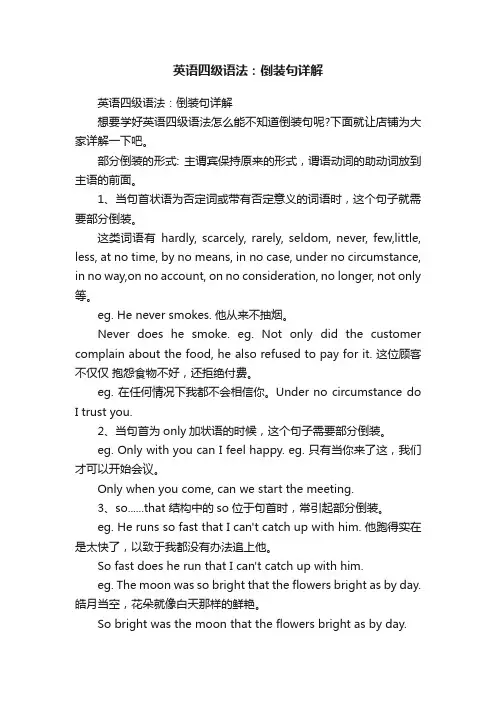
英语四级语法:倒装句详解英语四级语法:倒装句详解想要学好英语四级语法怎么能不知道倒装句呢?下面就让店铺为大家详解一下吧。
部分倒装的形式: 主谓宾保持原来的形式,谓语动词的助动词放到主语的前面。
1、当句首状语为否定词或带有否定意义的词语时,这个句子就需要部分倒装。
这类词语有hardly, scarcely, rarely, seldom, never, few,little, less, at no time, by no means, in no case, under no circumstance, in no way,on no account, on no consideration, no longer, not only 等。
eg. He never smokes. 他从来不抽烟。
Never does he smoke. eg. Not only did the customer complain about the food, he also refused to pay for it. 这位顾客不仅仅抱怨食物不好,还拒绝付费。
eg. 在任何情况下我都不会相信你。
Under no circumstance doI trust you.2、当句首为only加状语的时候,这个句子需要部分倒装。
eg. Only with you can I feel happy. eg. 只有当你来了这,我们才可以开始会议。
Only when you come, can we start the meeting.3、so......that 结构中的so位于句首时,常引起部分倒装。
eg. He runs so fast that I can't catch up with him. 他跑得实在是太快了,以致于我都没有办法追上他。
So fast does he run that I can't catch up with him.eg. The moon was so bright that the flowers bright as by day. 皓月当空,花朵就像白天那样的鲜艳。
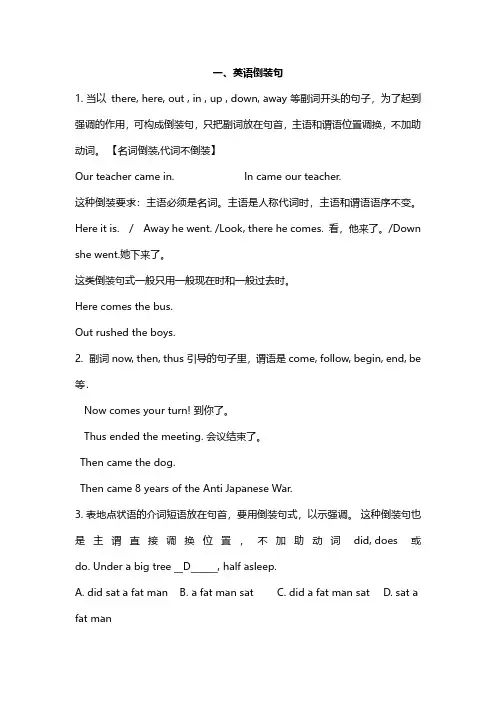
一、英语倒装句1. 当以there, here, out , in , up , down, away 等副词开头的句子,为了起到强调的作用,可构成倒装句,只把副词放在句首,主语和谓语位置调换,不加助动词。
【名词倒装,代词不倒装】Our teacher came in. In came our teacher.这种倒装要求:主语必须是名词。
主语是人称代词时,主语和谓语语序不变。
Here it is. / Away he went. /Look, there he comes. 看,他来了。
/Down she went.她下来了。
这类倒装句式一般只用一般现在时和一般过去时。
Here comes the bus.Out rushed the boys.2. 副词now, then, thus 引导的句子里,谓语是come, follow, begin, end, be 等.Now comes your turn! 到你了。
Thus ended the meeting. 会议结束了。
Then came the dog.Then came 8 years of the Anti Japanese War.3. 表地点状语的介词短语放在句首,要用倒装句式,以示强调。
这种倒装句也是主谓直接调换位置,不加助动词did, does或do. Under a big tree __D______, half asleep.A. did sat a fat manB. a fat man satC. did a fat man satD. sat a fat man4. there放在句首时,要用倒装句式。
在“there + lives, stands, comes, lies, flows, enters, rises 和appears等。
There came shouts for help from the river.There lies a large wheat field in front of the house.Many years ago there lived an old man in the wooden house. In front of the tower flews a stream. 5. so + 动词+主语 ; neither/ nor + 动词+主语 表示两人的同样一个情况时,只能表示一件事,即上、下句所使用的动词、时态要一致。
Inversion 倒装带否定意义的副词置于句首时带否定意义的词置于句首时,主谓语需要倒装。
Rarely does he go to the movies.Not for a moment did he doubt the truth of her honesty.Little do I know about the meaning of this proverb.Never before the night had I felt the extent of mypower.含有否定词的介词短语在句首时含有否定词的介词短语在句首时,句子主谓倒装。
这类介词短语包括:in no case, at no time, in no way, by no means, on no account, in no sense,u nder no circumstances, 等等。
意思为“决不,在任何情况下都不。
”“Only+状语”置于句首时的倒装“Only+状语”置于句首时,主谓语需要倒装。
1) Only by practicing a lot outside class can we speak English fluently.2) Only when I saw him did I remember that I promised to bring him a gift.3) Only then did I know that I was wrong.not only位于句首时的倒装句首是not only且连接分句结构时,引起局部(部分)倒装。
Not only did we lose our money, but we were also in danger of losing our live s.Not only can he sing very well, but he can also play some musical instrumen t very skillfully.neither,nor表示“也不”时的倒装句首是neither,nor表示“也不”时,主谓语需要倒装。
英语语法之倒装结构
倒装结构指在句子中将主语放在谓语的后面,或将助动词或情态动词放在主语之前,以达到强调或修辞的目的。
以下是倒装结构的几种形式和用法:
1. 完全倒装:将整个谓语都放在主语之前,即主语+谓语的完全倒装。
例如:
- In the garden sat a little boy.(一个小男孩坐在花园里。
)
- Not until the rain stopped did we go out.(直到雨停我们才出门。
)
2. 部分倒装:只将助动词、情态动词或一些表示否定、比较等的词组放在主语之前。
例如:
- Never had I seen such a beautiful sunset.(我从未见过如此美丽的日落。
)
- Neither did I enjoy the movie nor did my friends.(我和我的朋友们都不喜欢这部电影。
)
- So difficult was the exam that few students passed.(考试如此难以至于很少有学生通过。
)
3. 倒装疑问句:将助动词、情态动词或一些表示否定、比较等的词组放在句首,以构成疑问句。
例如:
- Can you swim?(你会游泳吗?)
- Did you see the movie last night?(你昨晚看了那部电影吗?)
- Have you ever been to England?(你去过英国吗?)
倒装结构的应用范围比较广泛,在正式场合、文学作品、口语交流等不同语境中都可以使用。
它通常用于强调、修辞或转换语气。
专四语法第15节-倒装和省略倒装一、知识要点英语陈述句的正常语序是主语在前,谓语在后。
但是在某些场合,为了强调、突出等目的会颠倒原有语序,这种句式叫做倒装(Inversion)句。
倒装句有两种形式:完全倒装(Full Inversion)和部分倒装(Partial Inversion)。
1、完全倒装将整个谓语动词或整个谓语部分都放在主语前面时,称为完全倒装。
使用完全倒装的情况有:(1)以here, there, now, then, from, out, down, in, up, away, on 等副词开头的句子,且谓语动词都是属于移动的含义,主语为名词时。
如:There followed a long silence. 接着是一阵长时间的沉默。
Now come the long-awaited guests. 盼望已久的客人们现在来了。
From the distance came occasional shots. 从远处不时传来枪声。
Out rushed a tiger. 一只老虎冲了出去。
*注意:如果上述情况中主语为代词,则句子不必倒装。
如:Out he rushed. 他冲了出去。
Here she came. 她来了。
(2)地点状语置于句首,且主语为名词时。
此类句中的谓语动词大多是表示走动或状态的不及物动词go, come, stand, sit, lie 等。
如:Under the tree sat an old wrinkled man. 一位满脸皱纹的老人坐在树下。
At the door stood a girl about the same height as mine. 在门边站着个跟我差不多一样高的女孩。
(3)表语放在句首以加强语气时,主语要放在be动词之后形成完全倒装。
如:Below is the blue ocean. 下面是蓝色的海洋。
(4) 有时为了强调,可将谓语部分的现在分词、过去分词或不定式置于句首,从而构成倒装。
英语专四语法总结:倒装结构
1.下列否定词及含有否定意义的词组修饰状语时,若置于句首,句子
的主谓要部分倒装
never, no, neither, not only, hardly, scarcely, little, seldom, rarely, not until, nowhere, at no time, on no account, in no respect, in no sense, by no means, in no way, no longer, no less, no more, no sooner than, under no circumstances, in vain, still less。
如:
Not only is its direct attack on their discipline, it bypasses the essence of what sociologists focus on.
Under no circumstances should we do anything that will
benefit ourselves but harm the interests of the state.
2.以only修饰状语开头的句子,句子的主谓要部分倒装
Only when you have obtained sufficient data can you come to
a sound conclusion.
3.以下列副词或短语开头的句子,句子的主谓要部分倒装
often, so, well, to such a degree, to such an extent, to
such extremes, to such a point,many a time。
如:
So involved with their computers do the children become that leaders at summer computer camps often have to force them to break for sports and games.
4.以下列副词开头的句子,句子的主谓要全部倒装
(1)出于修辞需要,表示方向的副词:out, down, in, up, away, on。
如:
Down jumped the burglar from the tenth floor when he heard someone shouted at him.
(2)出于习惯用法:here, there, now, thus, hence, then。
如:
Now is your turn. There goes the bell.
5.让步从句的倒装
(1)as引导让步状语从句,必须采用倒装结构,但不是主谓倒装,而是将被强调的内容置于句首。
如:
Much as I have traveled, I have never seen anyone to equal her, in thoroughness, whatever the job.
(2)出现在句型be+主语+其他, come what may中。
如:
Our civilization has accumulated an incredible amount of knowledge—be it scientific or artistic.
The business of each day, be it selling goods or shipping them, went quite smoothly. Come what may, I’ll be on your side.
6.比较从句的倒装
as, than引导的比较从句中,如果主语是名词短语且较长,经常采用倒装结构(不倒装也能够)。
注意:这种结构主语一般为名词,如果是代词则不倒装。
如:
Hydrogen burns much more cleanly than do other fuels and is easy to produce. Reading is to the mind as is exercise to the body.。